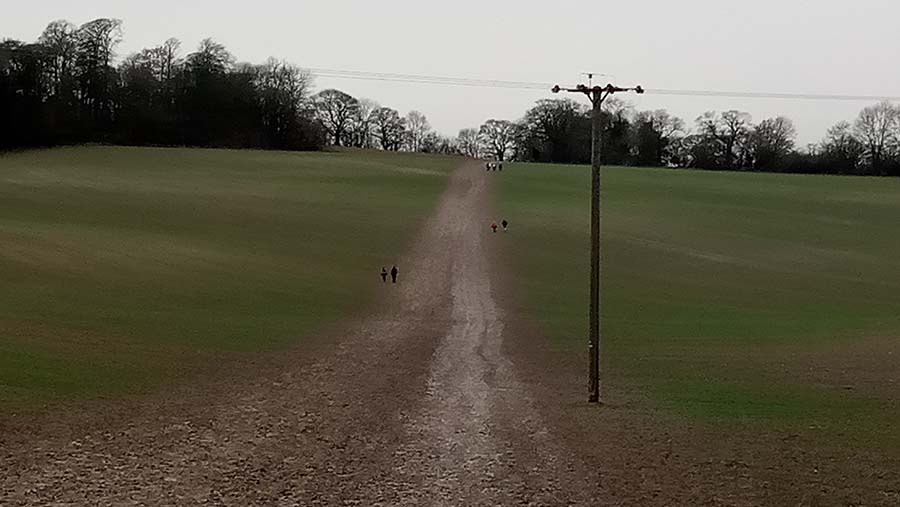Farmer counts cost after walkers stray from footpath
 Walkers negotiate the enlarged footpath © Buckmoorend Farm
Walkers negotiate the enlarged footpath © Buckmoorend Farm A Buckinghamshire tenant farmer is urging walkers to adopt a sensible approach to the use of public footpaths after suffering damage to large parts of his wheat crop.
Daniel Hares drilled a crop of winter wheat in early October in a 20ha field at Buckmoorend Farm, Butlers Cross, near Aylesbury, after leaving the field fallow the previous year for blackgrass control.
The field contains a 727m stretch of public footpath, which is normally about 1.5m wide – the minimum legal requirement – and allows walkers to enjoy panoramic views towards Aylesbury Vale as part of circular walks.
See also: Farming near footpaths – the law for arable farmers
But the farmer said increased footfall during the coronavirus pandemic had turned the footpath into a quagmire – and its width had increased from 5.5m at its widest in early November to as much as 11m in places today.
Mr Hares put up signs urging walkers to stick to the pathway, but this has not solved the problem and some of the signs have been knocked down.
Now he has decided to erect new signs and temporarily divert the footpath, asking walkers to use a 6m margin along the field boundary.
Crop damage
He estimates that about 0.69ha of the field has been damaged, which could have yielded about 6t of wheat – equivalent to 9,000 loaves of bread or about £1,000 in lost income.
When asked if he had a message to people visiting the countryside, Mr Hares called for a “common sense approach” and understanding of the role farmers play in producing food.
He told Farmers Weekly: “No one wants to stop people coming to the countryside. We want people to back British farming and enjoy our farms.
“Do reap the physical and mental health benefits of the countryside. But at the same time, be more aware of the countryside code and what farmers are doing.”
A photograph posted on Buckmoorend Farm’s Twitter page (@BuckmoorendFarm), showing people walking over the wheat crop on either side of the muddy footpath, has attracted much debate.
Temporary fencing
Some people urged Mr Hares to consider temporary fencing, but he said this option would “make a mess” and be impractical around growing arable crops.
Others suggested contacting the council for advice and submitting an application to the authorities to close and/or divert the footpath around the field perimeter, or possibly apply for permission to put in a cross-field hardcore path.
Defra has issued new guidance over public rights of way to landowners, following concerns raised by the industry over an increase in walkers in the countryside who may not be following the countryside code.
It notes that farmers must gain permission from relevant landowners/authorities for alternative uses or diversions of public rights of way.
An NFU spokesperson said: “The countryside is a busy working environment, so we need to ensure that the millions of people who visit every year can continue to do so safely and responsibly.
“The countryside code provides information to the public about how they can stay safe and enjoy the countryside responsibly. This includes keeping to public rights of way where safe and appropriate to do so.”
CLA considers options for landowner
Given the location of the Chiltern Hills and its accessibility, it’s no wonder Mr Hares’ footpath is popular with visitors wanting to enjoy the countryside, the Country Land and Business Association (CLA) says.
CLA chief legal adviser Andrew Gillett said: “During this wet winter and with many of us understandably wanting to go walking, it is not surprising that public footpaths, like this one, can come under strain.”
Informative signs can help, as can erecting fencing, whether temporary or permanent, but this would need careful consideration, especially if it is a cross-field path which could affect farming practices, he added.
It might be an option for the landowner to provide an alternative route, or permissive path, around the field edge, he said. “There is no guarantee that people would use this path, but if it is less muddy and clearly signed, then it may prove a popular choice.”
If he takes this option, Mr Gillett recommends that the landowner notifies his insurer and clearly signs it as a permissive path.
“In the long term, another potential solution is to apply for a diversion. However the process can take a long time and there is no certainty of success,” he said.
